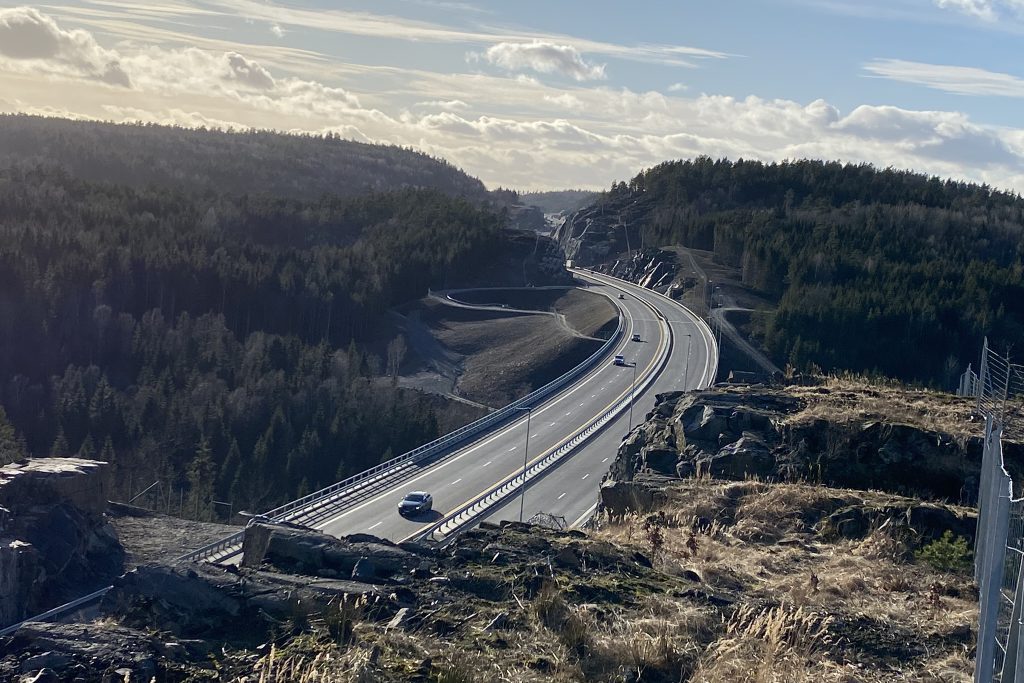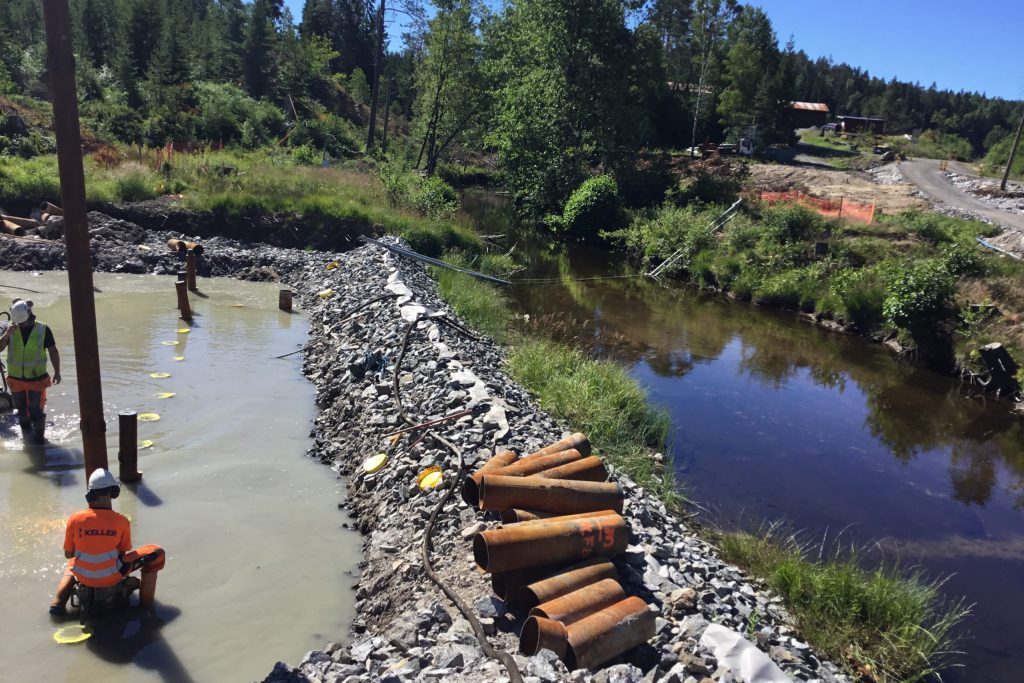New E18 Rugtvedt motorway in Dørdal, Norway achieves CEEQUAL Excellent
Overview
The E18 motorway in Norway has improved road safety, reduced journey times and reduced greenhouse gas emissions. This stretch of road was built by Nye Veier and achieved a CEEQUAL (now known as BREEAM Infrastructure) rating of Excellent.
About
Nye Veier plans, builds, operates and maintains traffic-safe main roads in Norway. Its aim is to reduce travel time, connect residential and labor market regions and ensure fewer people are killed or seriously injured in traffic.
Background
This four-lane motorway in Telemark, Norway has a 110 km/hour speed limit. The state-owned company, Nye Veier AS, took over the responsibility to build the project in 2016. The project includes the construction of two major intersections with crossover bridges, nine four-lane bridges, two wildlife crossing constructions, and several minor constructions.
Challenges
The driver for undertaking a CEEQUAL assessment on this project was to document what had been done and how Nye Veier can improve in terms of sustainable infrastructure development.
The project set a range of ambitious targets for the new stretch of road:
Reduction in travelling times from 16 to 9 minutes.
Reduction of number killed and seriously injured in road traffic. The new E18 shall have an accident frequency lower than 0.02.
Reduce greenhouse gas emissions in line with Norway’s climate goals and limit the loss of biodiversity. Reduction of CO2 emissions by 20% during the construction phase compared to baseline estimate.
A net benefit of 1.32 per invested NOK, based on a cost framework 20% below the baseline total cost estimate of NOK 4,505 billion.
An increased road user benefit on annual basis in 2020 compared with 2016 of NOK 195 million.
In the early phases (2010-2013), the project location was chosen to avoid nuisance to living and agricultural areas and was therefore placed mostly through forested areas, partly including locations of high ecological value. Thus, the project made efforts to reduce encroachment in these areas, although some conflict could not be avoided.
All measurable project goals were achieved, and some were exceeded. The project successfully minimised the impact on areas with high ecological value and achieved a climate gas reduction of more than 20% in the construction phase.
Limitations of site placement resulted in some impacts on local biodiversity, e.g. within the facility a population of the red-listed bee Andrena marginata, also called the small scabious mining bee, was found. To maintain the population, sand mounds were placed in several places near the previous locations and 8000 devil’s-bit, on which the bees depend, were planted.
Solutions
Management
Through thorough assessments in the planning phases, the project location was selected to minimise adverse impacts on biodiversity, cultural heritage, natural resources, living areas, and outdoor life. This, in combination with extensive contract requirements and the Best Value Procurement method, resulted in a score close to 90% in this category.
Resilience
The project conducted thorough risk assessments including future needs and traffic growth as well as climate change and planned for resilience of the assessed risks. It was designed for a 200-year flood event with 50% climate change addition. A 100% score on these issues was very satisfactory.
Communities and stakeholders
The Norwegian Plan and Building Act regulates the consultation with local stakeholders. The project paid significant attention to conduct open information meetings and open office days where the stakeholders could address their concerns. In addition, supplier days with speed dating allowed contractors and suppliers to present themselves and encouraged local firms to bid for their services. The client also addressed the wider economic benefits to society as result of the project. These actions resulted in close to 90% score in the category.
Land use and ecology
In the early phases of the project (2010-2013), the location was chosen to avoid nuisance in living and agricultural areas. It was therefore placed mostly through forested areas, partly including locations of high ecological value. The project made efforts to reduce encroachment in these areas by intervention limitation, although some conflict could not be avoided. In addition, it prepared compensation areas for the threatened species Andrena marginata found in the construction area. A score of more than 80% was achieved with this strategy, which was satisfactory.
Landscape and historic environment
A wide range of stone age settlements were identified within the project location. However, there were no cultural remains of a newer age affected by the project. All stone age settlements were excavated before start-up of the constructions. The excavations resulted in a comprehensive scientific textbook. The project achieved close to 80% score on these issues, which could have been improved by better information to the local community.
Pollution
With a large construction project like this with more than 30 streams and rivers it was difficult to avoid temporary pollution, although significant work was done to prevent it including using temporary dams and continuous measurements with alarm limits. All waterways (streams, rivers, and lakes) were monitored before, during, and after construction. Ongoing monitoring continued for two years after the project completion and see now that the temporary effects are fading away and that there has been no permanent damage. The 62% score in this category could have been raised if the results of after construction monitoring had been available during the assessment.
Resources
Greenhouse gases were reduced by more than 20% in the construction phase compared to the baseline. This was accomplished by reducing bridge lengths, using internally produced stone for road construction and embankments at bridges, using locally produced cement for all concrete constructions, using mobile and gas fired asphalt works inside the construction area, and using materials with EPD requirements for low CO2 emissions. A higher score could have been achieved with more attention to material resource efficiency, circular economy, PAS 2080, and water use.
Transport
The score in this category was 85%. This was satisfactory, but the client reflected that the project could have better documented its planning and implementation regarding construction materials and workforce travel planning, meaning there was potential for improvement in this category.
Metrics for this project
The following is the available information on carbon emissions and other climate and environmental metrics.
Carbon emissions:
Construction 61.116 tonnes CO2e reduction (~20% reduction from baseline estimate).
Operation 40 years 18.729 tonnes CO2e reduction (~30% reduction from baseline estimate).
Diesel:
12 mill l, with 7% biodiesel content.
Electricity:
1.7 mill kWh in total.
Excavated material:
Bedrock 4.1 mill. fixed m3, 1.1 mill. m3 reused in construction.
Soil: 1.4 mill m3, 0.35 mill m3 reused on the project.
Recycled materials:
Armouring steel 5820 tonnes.
Locally supplied materials:
Concrete ~70,000 m3 (environmentally friendly cement (Norcem BV45 SV standard) locally produced, all elements of concrete were locally produced within 15 km from project location).
Asphalt: total production ~165,000 tonnes locally produced, ~ 80% of filler locally produced within production area ~ 132,000 tonnes.
Building blocks for retaining walls: ~3500 m2, produced 90 km from construction site.
Steel lids for drainage sumps in total ~33,000 pieces produced with electric energy ~ 50 from construction site.
Embodied water 15% of concrete volume 10,500 m3
Benefits
The CEEQUAL assessment was initiated when the construction phase was completed, so although CEEQUAL did not directly provide financial benefits, significant cost reductions were achieved through good planning and project management. The use of the Best Value Procurement method, a bonus reward for improvements during detailed design and the selection of turnkey contractor, resulted in a 20% reduction of the maximal construction cost set for the project. However, the use of CEEQUAL helped raise our awareness of the benefits, both economic and others, that can be achieved by using CEEQUAL from the early planning phase.
The client reported that use of CEEQUAL has improved attention to documentation, and the importance of evaluation, planning, and implementation of various issues. Additionally, it has helped them improve sustainability performance, reduce carbon emissions, and increase the socio-economic benefits in other ongoing and upcoming projects, which all are among Nye Veiers corporate targets.
The CEEQUAL assessment for this project was done after project completion. The major outcome was a documentation and independent evaluation of what had been done and learning what can be done better in future projects.
The most significant examples of best practice and innovation in the project were:
Reducing concrete constructions using locally produced surplus of bedrock material.
Producing crushed stone for construction of the road base on site.
Using gas fired mobile asphalt works within the construction area.
Summary
Espen Hoell, Nye Veier AS





